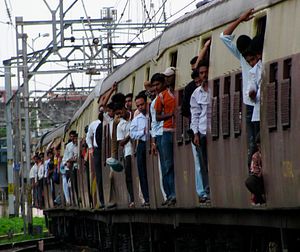India boasts the world’s largest rail network, with over 25 million people traveling on some 11,000 trains every day. The railways that snake across India, a colonial inheritance first built to transport troops across the country, are the crucial economic lifeblood of the country, enabling the movement of goods and people.
This week, in a hugely contentious move, India’s Railways Ministry hiked up the cost of traveling by train. From June 25 the cost of tickets for passengers will increase by 14.2 percent, while the costs for transporting freight will go up by 6.5 percent. With India’s low-cost airlines racing to the bottom on prices to win customers, the rail fare increases mean that, on some popular routes, it is now more expensive to travel by train than it is to fly.
The decision provoked angry demonstrations as people and political groups took to streets and railways stations across the country to protest against the decision. Two petitioners in Mumbai resorted to legal proceedings, filing suits in the Bombay High Court to try and prevent the fare increases coming into force. The announcement also proved divisive within the ruling coalition. MPs from the Shiv Sena party – a junior coalition partner with its main support base in the state of Maharashtra, home to the city of Mumbai where 7.5 million people commute on local services every day – called on the Railways Minister, Sadananda Gowda, to reverse the increases.
But these reforms, part of the “bitter medicine” that Prime Minister Narendra Modi has prescribed to restore India’s economy, are, if anything, insufficient. India’s railway network is one giant loss-making enterprise. Despite the heavy traffic on India’s trains the network loses 26,000 crore rupees (1 crore = 10 million) every year. 8,000 crore rupees are set to be recovered by the price rises but much of this will go towards increases in the cost of fuel, leaving a deficit of 14,000 crore rupees.
The fact that the announcement triggered protests is significant, and demonstrates India’s “subsidies trap”: the use of public funds to provide low-cost services becomes politically costly as politicians risk losing support when trying to withdraw those funds. Indeed India’s previous government, the center-left UPA coalition, was accused of trying to cash in on the electoral rewards of subsidies by pandering to the “poor vote” through the roll out large state-welfare schemes.
Policies related to trains – considered the “poor man’s chariot” because of their importance to migrant laborers and poor travelers – are particularly sensitive. The last major adjustment in rail fares was carried out in 1999 and, although there have been increases in the interim, one of these was rolled back. Indeed in May of this year, before the elections were concluded, the previous UPA government deferred its planned increases in rail fares, arguing that it was the prerogative of the new government to decide on the matter.
State subsidies for railways stem from a colonial-era financing regime that remains in force: finances for the rail network are kept separate from the national budget as per recommendations made by the Acworth Committee in 1921. This fiscal segregation forces the state to cover the enormous losses: according to figures published by the Indian Express, the railways spend two rupees on passengers for every one rupee they recoup on tickets. This budgetary ring fencing is no longer sustainable: the cost of running the rail network equates to 15 percent of the national budget and various high-ranking officials are now petitioning for the two budgets to be integrated, a merger that would place India’s Finance Ministry in charge of investment and development.
The price rise announcement cheered the markets, which welcomed the step as proof that India’s new government is prepared to cut the country’s expensive subsidies and in turn tackle the fiscal deficit.
But there remains the problem of the quality of India’s network. It is beset by the problems of under-investment: India’s trains are unsafe, poorly maintained and under-developed. Thousands die on rail crossings, in train crashes and in rail accidents every year. Privatizing parts of the network and inviting foreign investment are now being suggested to address these pressing infrastructural needs. Until then these fare hikes represent a necessary, but short-term, palliative.

































